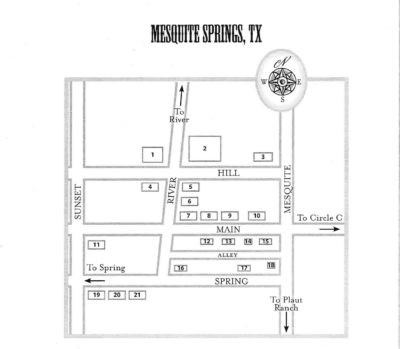

 Ten years after her parents were killed, Evelyn Radcliffe is once more homeless. The orphanage that was her refuge and later her workplace has burned to the ground, and only she and a young orphan girl have escaped. Convinced this must be related to her parents’ murders, Evelyn flees with the girl to Mesquite Springs in the Texas Hill Country and finds refuge in the home of Wyatt Clark, a talented horse rancher whose plans don’t include a family of his own.
Ten years after her parents were killed, Evelyn Radcliffe is once more homeless. The orphanage that was her refuge and later her workplace has burned to the ground, and only she and a young orphan girl have escaped. Convinced this must be related to her parents’ murders, Evelyn flees with the girl to Mesquite Springs in the Texas Hill Country and finds refuge in the home of Wyatt Clark, a talented horse rancher whose plans don’t include a family of his own.
At first, Evelyn is a distraction. But when it becomes clear that trouble has followed her to Mesquite Springs, she becomes a full-blown disruption. Can Wyatt keep her safe from the man who wants her dead? And will his own plans become collateral damage?
Suspenseful and sweetly romantic, Out of the Embers is the first in a new series that invites you to the Texas Hill Country in the 1850s, when the West was wild, the men were noble, and the women were strong.
PRAISE FOR OUT OF THE EMBERS: “Out of the Embers is part prairie romance, part romantic suspense. I can’t remember when I’ve enjoyed a book more. Amanda Cabot has written an intriguing, chilling mystery and she winds it through the pages of a sweet romance in a way that made me keep turning the pages fast to see what was going to happen next. An absolutely excellent read. And now I’m hungry for oatmeal pecan pie!”
Baker Book House ┃ Amazon ┃ Barnes & Noble
┃ Christianbook.com ┃ Books-A-Million ┃ Kobo ┃
┃ Additional Retailers ┃



Who Needs a Map?
Guest Post by Amanda Cabot
In the world of GPS, who needs one of those old-fashioned paper maps? I do, and – judging from the notes I’ve received from readers – so do many readers.
I’ll admit it. From childhood on, I’ve been fascinated by maps, especially by street maps of cities, but it was only when I started writing that I realized just how valuable they could be for an author. Whether the locations are real, as was the case with my Westward Winds books, or fictional like the town of Mesquite Springs, I have a map spread out in front of me while I write. That map’s as important to me as my chapter-by-chapter outline.
When I create a map, I begin with street names, landmarks, topography, and orientation. Street names and landmarks are self-explanatory. By topography, I mean the presence of hills, forests, rivers, or other natural features that might play into the story. Orientation refers to the direction on the compass. Does the main street run north-south? Which direction does the town hall face?
Once I have that information, I pencil in the location of my characters’ homes as well as other buildings that play a role in the story. It’s only when I have all the locations established that I start to write.
Why would I or any other writer do this? I view it as a form of research, a case of knowing as much as I can about my characters’ lives before I begin to tell their stories. But it’s more than that. Having a good map is important for three reasons.
It increases the book’s accuracy. If I know the compass orientation of the street where my characters are staying, when I’m describing the shadows a tree casts at 3 PM, I know which direction those shadows are falling. I also know whether my heroine would see a sunrise from her kitchen window.
A map assures consistency. Readers are astute. If my character turns right one time to go from his house to the church but heads left the next time, the reader will notice the discrepancy. It may not stop her from reading the rest of the story, but it will brand me as a sloppy writer. Who needs that?
A map allows me to add the details that bring my fictional world to life. Once I’ve created the map, I can calculate the distance between points and can determine how long it will take to travel that distance. I can mention landmarks characters pass along the way. And, of course, since I have the map, those details will be accurate and consistent.
To me, maps are a key part of the writer’s toolbox. I love them, and that’s one reason I’m delighted that Revell includes maps of my towns in my books.


 Amanda Cabot is the bestselling author of the Cimarron Creek trilogy, as well as the Texas Crossroads series, the Texas Dreams series, the Westward Winds series, and Christmas Roses. Her books have been finalists for the ACFW Carol Awards, the HOLT Medallion, and the Booksellers’ Best. She lives in Wyoming.
Amanda Cabot is the bestselling author of the Cimarron Creek trilogy, as well as the Texas Crossroads series, the Texas Dreams series, the Westward Winds series, and Christmas Roses. Her books have been finalists for the ACFW Carol Awards, the HOLT Medallion, and the Booksellers’ Best. She lives in Wyoming.VISIT THE OTHER GREAT BLOGS ON THE TOUR:
|
3/10/20
|
Notable Quotable
|
|
|
3/10/20
|
Review
|
|
|
3/11/20
|
Review
|
|
|
3/11/20
|
BONUS Post
|
|
|
3/12/20
|
Excerpt, Part 1
|
|
|
3/12/20
|
Author Interview
|
|
|
3/13/20
|
Character Spotlight
|
|
|
3/13/20
|
Review
|
|
|
3/14/20
|
Guest Post
|
|
|
3/15/20
|
Author Interview
|
|
|
3/16/20
|
Excerpt, Part 2
|
|
|
3/16/20
|
Review
|
|
|
3/17/20
|
Review
|
|
|
3/18/20
|
Excerpt, Part 3
|
|
|
3/19/20
|
Review
|
|
|
3/19/20
|
Review
|


Note: Some posts may contain affiliate links. Should you choose to purchase a product, we will receive a small commission for the sale at no additional cost to you. Chapter Break is a participant in the Amazon Services LLC Associates Program, an affiliate advertising program designed to provide a means for sites to earn advertising fees by advertising and linking to Amazon.com.




